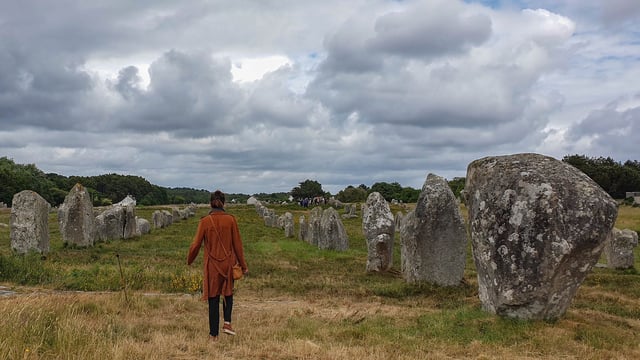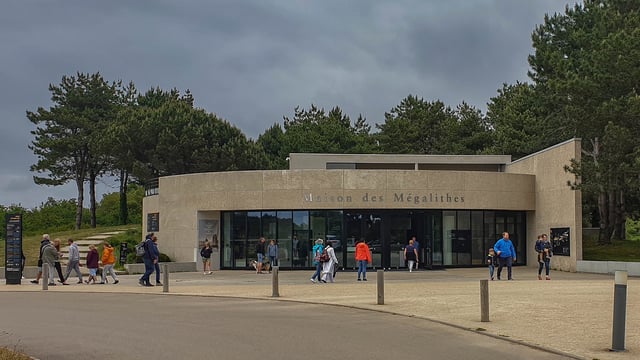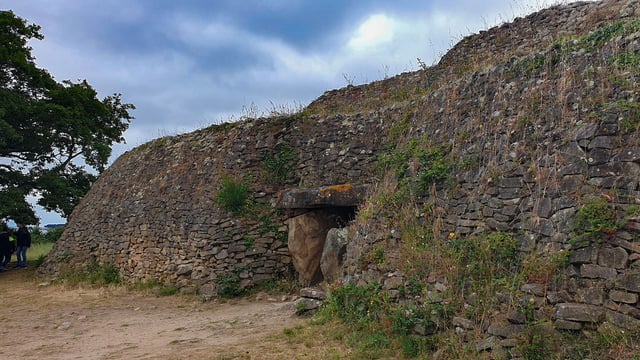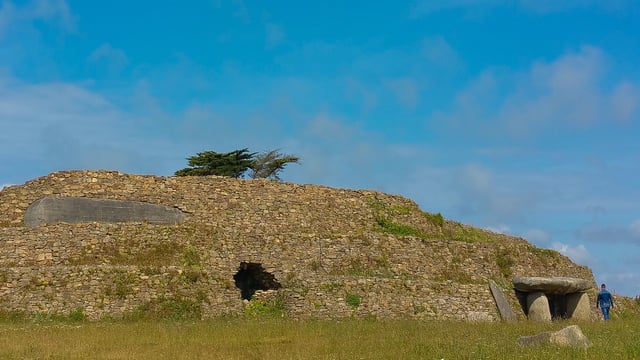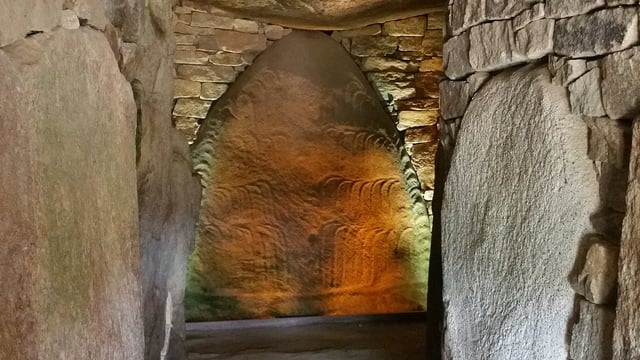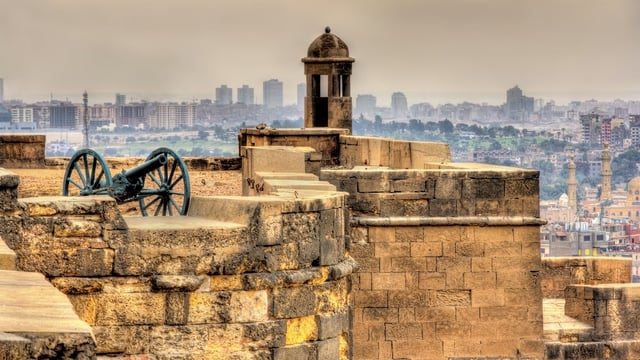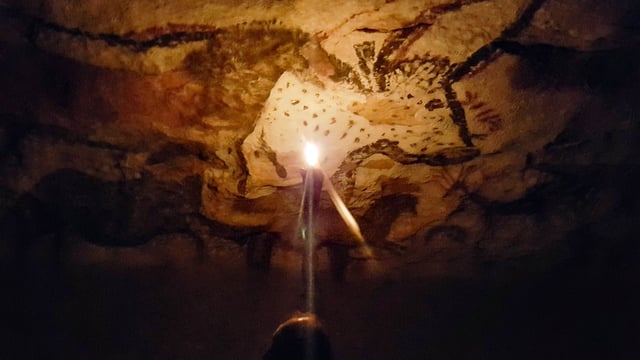Brittany, that peninsula in north-west France that juts out into the Atlantic with its distinctive cultural history, has the largest concentration of megalithic stones in Europe. Here you will find the World’s tallest menhir, the most extensive stone alignments, the biggest dolmen, and the largest megalithic cairn. And, within the region, it is the southern coastline, the peninsulas and islands in and around the Gulf of Morbihan, that has the unparalleled diversity of megalithic sites.
- Thomas Dowson
- Last Checked and/or Updated 7 February 2023
- No Comments
- France Travel Tips, Travel Tips
Southern Brittany is a wonderful area to visit, and not surprisingly it is one of France’s more popular tourist destinations. The area, like much of Brittany, has not been heavily industrialised; fishing and agriculture having being the principal economic activities for centuries. Consequently the coastline has many picturesque fishing villages. For anyone who enjoys seafood you will be in gastronomic heaven. You can be assured of a fresh plateau fruits de mer – a platter of assorted seafood – the region is proud of and not to be missed.
And there is also the megalithic archaeology. While there are menhirs and dolmens throughout France, Brittany not only has the greatest concentration of megalithic sites, it also has a great diversity of site types. Making this a great archaeological destination for anyone wanting to experience first hand a variety of megalithic sites.

Diversity of Megalithic Sites in the Carnac Area
Some people think the word ‘dolmen’ is plural. But, it is one dolmen and two dolmens. This is because the more colloquial terms we use for some of the megalithic structures associated with the Neolithic and Bronze Age of Europe come from Breton, the traditional Celtic language of Brittany. Dolmen is Breton for stone (men) table (dol), while a menhir is a tall (hir) stone (men).
A number of the menhirs in Brittany are between eight and twelve metres high. The tallest is at Locmariaquer, and called the Grand Menhir Brisé (the great broken menhir) – but it is no longer standing. When erect, if it ever was erected, it measures 20 metres in height. Strictly speaking menhirs are usually found on their own. When there is more than one, the standing stones are in lines, these are called stone alignments. The most extensive stone alignments are to be found in the Carnac area. Here there are thought to have once been four discrete fields of stone alignments. One of these, Le Ménec alignments, has 1,050 standing stones in lines that run for about 950 m.
As the Breton name implies, a dolmen is much like a table. The most simple comprises three slabs, two up right, supporting a flat slab which would have been the roof slab of a burial chamber. This table-like structure would have been covered by earth and or stones, and where these survive they are called cairns. Excellent examples of these in the Gulf of Morbihan can be seen at Locmariaquer and on the island of Gavrinis. Although there are many small dolmens that are simple made up of two or three standing slabs with a single roof slab, often a series of dolmens are placed side by side (see the example in the photo to the right). This produces a covered alley or passageway – hence the term passage tomb. The decorated passage tomb in the Gavrinis Cairn is, along with Newgrange in Ireland, perhaps one of the most spectacular examples in Europe.

Megalithic Pass – Pass des Mégalithes
Given this diversity of megalithic structures, the Carnac area is a good choice for base from which to explore megalithic archaeology. While there are a number of sites to visit in the Gulf of Morbihan region, many of the better examples charge an entry fee. Visiting them all then soon starts adding up, particularly if you are travelling on a budget.
If you just want to visit one or two sites out of curiosity, I would recommend going to the stone alignments on the northern edge of Carnac, and stretching eastwards. The lines of standing stones are mostly fenced off and there is a charge for anyone wishing to go on a guided tour within the restricted area. But, you can just as easily get a good impression of the site by walking around the perimeter fence. Then, pay to visit either Gavrinis (this involves a boat trip to a small island) or the group of megalithic sites of Locmariaquer.
On the other hand, if you want a deeper understanding of the megalithic tradition around the Gulf of Morbihan, this will entail visiting a number of sites and an entry fee at each one. Fortunately, for those with a budget – and also to encourage people to visit more than one site – there is a partnership scheme of five of the main sites and museums that provides discounted rates.
The Pass Mégalithes is free. Essentially it is a ticket that is given to you at the first of the five sites you visit. On it are all the details of the participating sites. When you visit the first site, your ticket will be stamped. Then, when you visit the second and subsequent site or museum in the scheme your entry fee is reduced.
The Megalithic Pass is worth taking advantage of; the five participating sites (listed below) are the principal megalithic attractions in the area. And I thoroughly recommend visiting each of them if you have two or three days at your disposal for archaeology. Of course if you want to spend more than two days, there are other sites to visit. These are included in the various guides to the megaliths of the area, a number of which are also well signposted.
Many of the sites have very good Visitor Centres, the one at Locmariaquer is worth a specific mention. Here, a video is shown regularly throughout the day that gives a good overview of the archaeology of the area and how the landscape has changed since the time these structures were constructed. The Megalithic Visitor Centre at Le Ménec Alignments is another good one. On top of both of these buildings are viewing areas that provide a high vantage point from which to get a more aerial view of the intriguing layout of these sites.
Where to Start?
My recommendation is to start your tour of the area with an hour or two at the Prehistory Museum in Carnac. The museum has just recently been renovated and the pre-Roman exhibits give superb overview of what we know about the time these structures were raised. Then plan your route around the area stopping at the sites that are included in the scheme depending on availability.
Getting to Gavrinis, for example, requires getting a ferry. You will have to factor the times those are available. If you want a tour of the standing stones, they are only offered at certain times. Before, or after going into the stones, be sure to stop at the Visitor Centre at Le Ménec Alignments – known as the Maison des Mégaliths. The book shop has an excellent collection of guides to suit all levels of interest. Should you wish to take a guided tour and walk amongst the standing stones, this is the place to go. Also from here, there are little trains that tour the various alignments – great for the kids!
There is an excellent series of displays and videos that give a very good introduction to the archaeology of the area. From here you can explore megaliths throughout the area until your interest is satisfied.
Sites & Museums in the Megalithic Pass
Carnac Prehistory Museum
The Musée de Préhistoire de Carnac is housed in an old rectory with a collection of over 7,000 artefacts from many of the megalithic sites in the area – one of the richest museums for megalithic culture. A handful of display that deal with the various aspects of everyday life, but the museum has a greater focus on the development and significance of funerary architecture, from the early dolmens to the later, more complex passage tombs. A few galleries explore the Iron Age and Roman periods.

Maison des Mégaliths, Carnac
Besides serving as an information point and a ticket office for guided tours of the Carnac stone alignments, the Maison des Mégalithes also has a series of exhibitions outlining the history and understanding of the megalithic tradition in southern Brittany. The viewing platform on top of the building is a viewing platform that gives a better view of the alignments than you will get at the fence.

Carnac Stone Alignments
The different series of stone alignments to the north of Carnac are made up of over 3,000 individual standing stones – they are the largest concentration of megaliths in the World. Thought to have been erected between 7,000 and 4,000 years ago, the lines of standing stones cover a distance of about four kilometres in total. Although now fenced off, guided tours of certain sections of the stones are available that enable visitors to walk among the stones. These guided tours are highly recommended.

Gavrinis Passage Tomb
The stone cairn with its decorated passage tomb is not only one of the more spectacular Neolithic sites in the Morbihan area, it is also a great day out for the whole family. Today, because of the rise of sea levels since it was built, the cairn is now on a small island, and the only means of getting there is a short ferry ride from the nearby coastal fishing village of Lamor-Baden. Once on the privately owned island a guided tour enables access to the decorated passage tomb.

Petit Mont Chambered Tomb & WWII Bunker
The cairn of Petit Mont is thought to be one of the most significant chambered tombs in Brittany. Although this is for all intents and purposes a ‘Neolithic site’, from about 6,600 years ago, it is an excellent example of how monuments constructed in one period are re-used in subsequent periods. Artefacts recovered during excavations show that this site was also in use during the Bronze Age and the Gallo-Roman period. But the most obvious evidence of re-use is the typical German bunker built into the cairn in 1943.

Megalithic Sites of Locmariaquer
There are a number of megalithic sites in the seaside town of Locmariaquer. The main site open to the public is an intriguing cluster of different megalithic structures. This includes the tumulus of Er-Grah, the Tables des Marchands Cairn, and a enormous broken menhir – which is thought to be the biggest prehistoric stone stele in Europe. Not to be missed is the large, decorated megalith inside the cairn, which is open to the public. The Visitor Center has a very informative short documentary about the megalithic tradition in the area.




